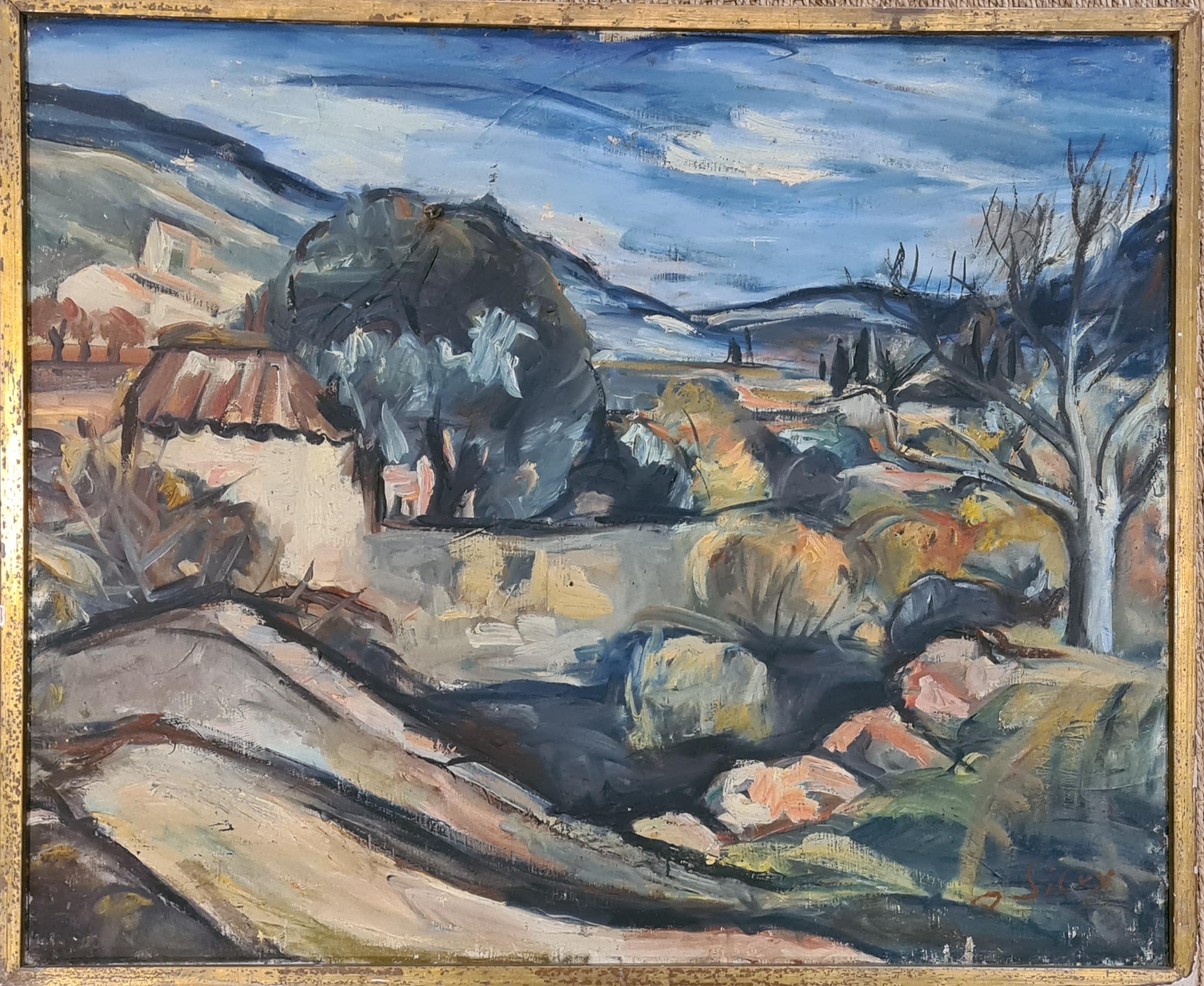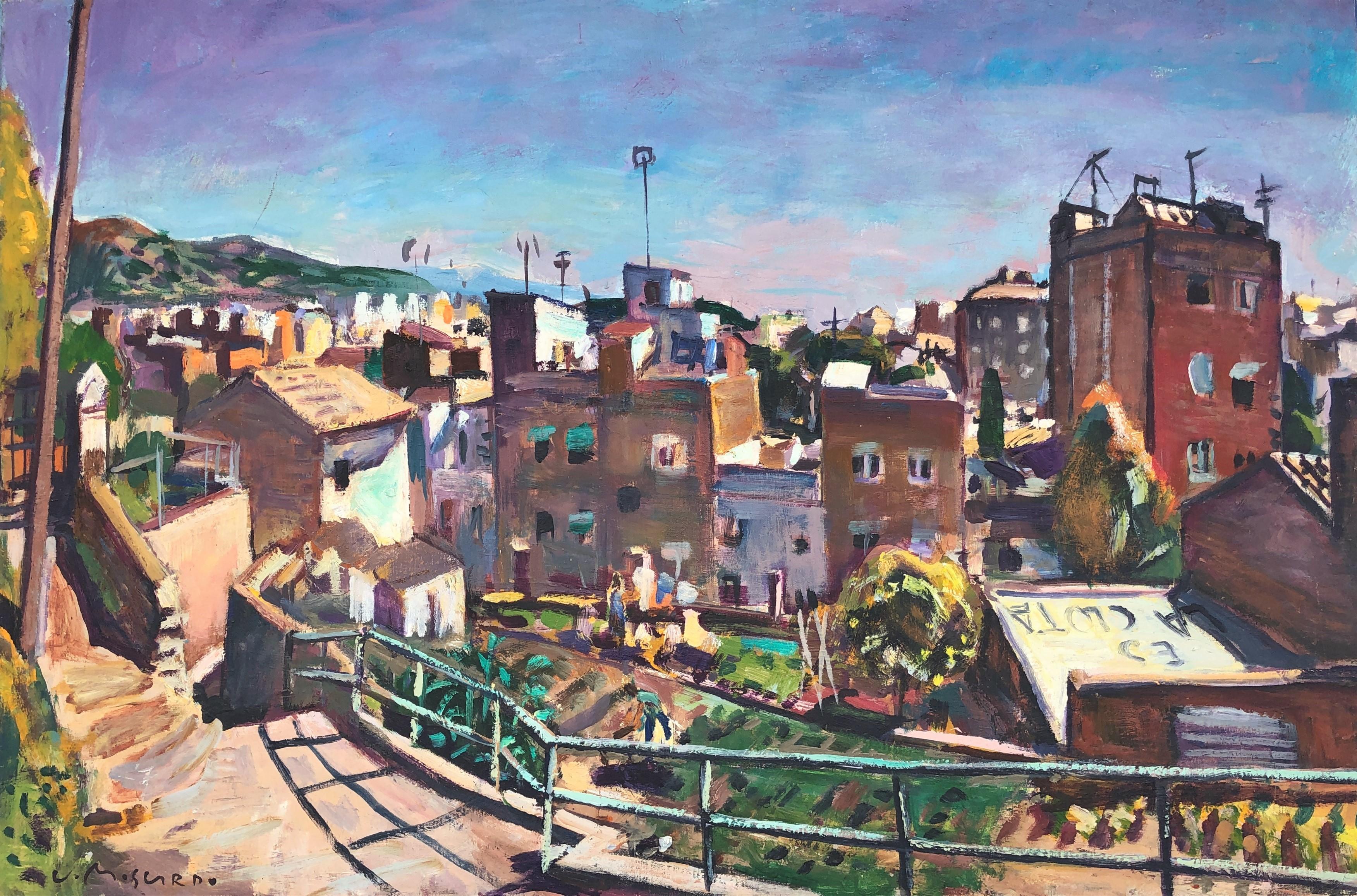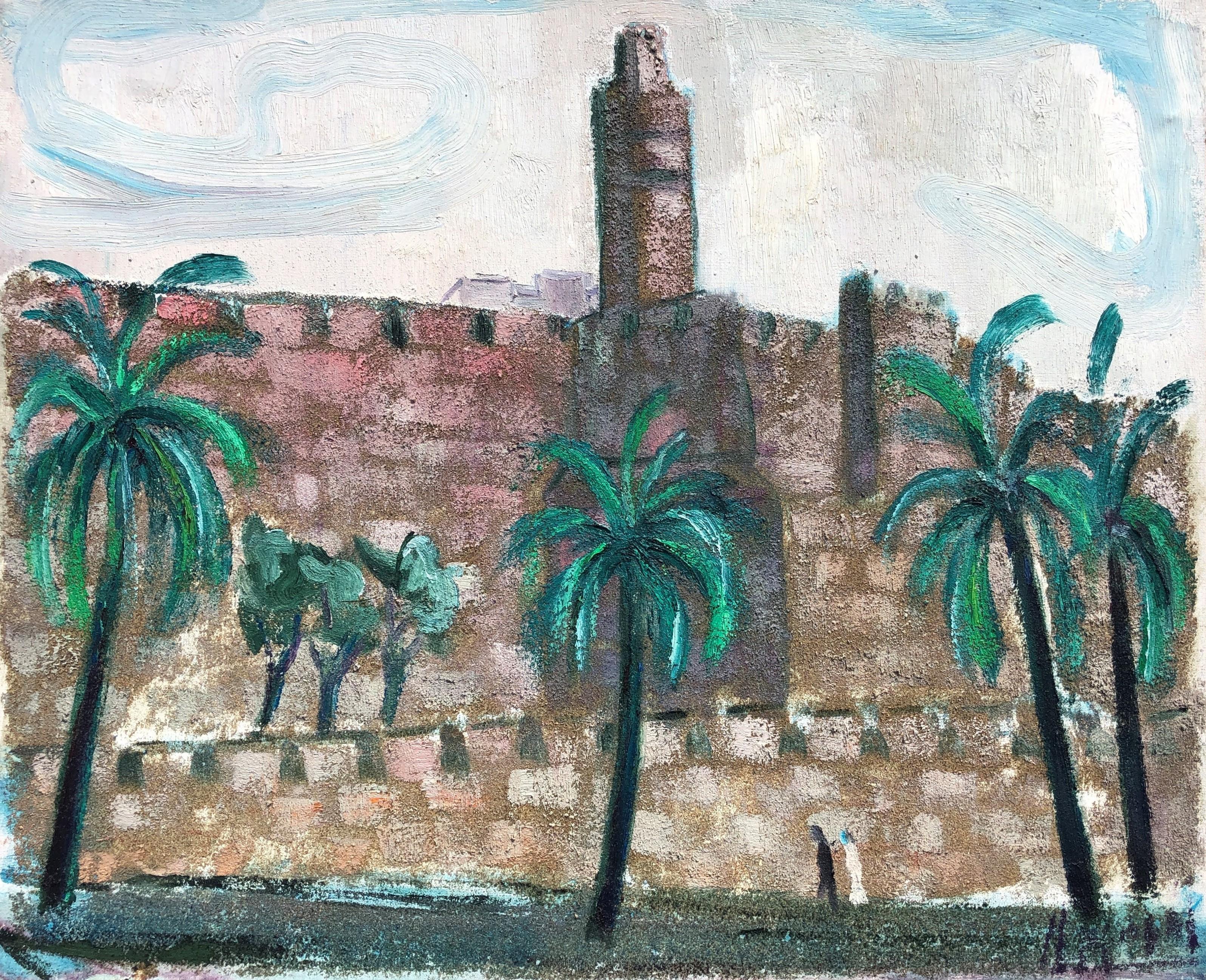Items Similar to Forest Clearing, Oil on Canvas, Painted 1933.
Want more images or videos?
Request additional images or videos from the seller
1 of 8
Sigfrid UllmanForest Clearing, Oil on Canvas, Painted 1933.1933
1933
About the Item
A painting of a forest clearing in intense green and yellow colors by Sigfrid Ullman (1886 - 1960). Oil on canvas laid on board. Signed with monogram SU and dated 1933. Frame later.
Sigfrid Ullman was a Swedish artist who started his artistic career in Althin's Painting School in Stockholm between 1901–1902 then he went on to the Technical School 1902–1904 followed by Warner Silfversparre's Graphic Institute 1904–1905 and the "Konstnärsförbundets" (Artists association School) third school in the years 1905–1908. Anders Zorn was one of its teachers. In the latter school, he became acquainted with several of the first Swedish modernists. During his nine Stockholm years, he spent the summer in Varberg, where he got to know Birger Simonsson and a lifelong friendship began. He spent the summer of 1909 in Simlångsdalen together with Simonsson, Knut Janson and Isaac Grünewald where they depicted the nature of Halland. In the fall of 1909, he traveled to Paris and started at the Académie Matisse, where several of his artist friends from the Konstnärsförbundet had already started.
After completing military service, he came to Stockholm in the fall of 1910 and in the summer of 1911 traveled to Fjällbacka to paint a west coast environment.
Ullman became a member of the group De unga in 1908 and participated in all the exhibitions the group held. The critics were mostly positive at the exhibitions held in 1910 and 1911. He then traveled to Copenhagen where he studied at Rohde's art school (formerly Zahrtmann's ) in Copenhagen 1911–1912. After a short stay in Gothenburg in 1912–1913, he traveled together with Simonsson and Gösta Sandels to St. Chamas in Provence where they stayed a few months for study and painting.
He lived alternately in Gothenburg and Varberg 1913–1915 before he was permanently resident in Lerum on the west coast 1915–1919.
After the dissolution of the artist group De unga, the three artist friends Simonsson, Sandels and Ullman formed the Gothenburg group.
Between 1919–1929 Ullman was abroad and joined the group of former Matisse students who went by the name Falangen, and which had their first appearance in Stockholm in 1922. The first five years, he spent in Paris before moving on to Rome in 1924 –1928 and then finally in Copenhagen 1928–1929.
On his return to Sweden in 1929, he was employed as Tor Bjurström's successor as a teacher at the Gothenburg museum drawing and painting school. As a teacher, he was considered very strict and he made a special effort to teach the students to draw. He remained on the teaching post until 1938 and then lived most of his life in Gothenburg.
Separately, he exhibited, among other things, at the art gallery God Konst in Gothenburg in 1946, in Oslo in 1934 and at the Swedish-French art gallery in Stockholm in 1942. Together with his wife Nanna Johansen-Ullman he exhibited in Gothenburg in 1932 and together with Tore Ahnoff at the Konstgalleriet in 1950. He participated in a collective exhibition of Gothenburg art in Copenhagen in 1915, Konstnärsförbundets exhibition in Stockholm in 1916, Moderne Svensk Kunst in Copenhagen in 1916, the Unionalen art group's exhibitions in Stockholm in 1927 and in Copenhagen in 1931, as well as Gothenburg art at Liljevalch's art gallery in 1947.
A memorial exhibition was shown at Gothenburg's Art Gallery in 1961, and memorial exhibitions have also been shown in Varberg and Borås. He was one of the initiators of the formation of Gothenburg's artists' club in 1933 and was the club's first chairman until 1939. His preserved archives and notes are kept at the Gothenburg University Library.
Ullman received the Gothenburg City Medal of Merit in 1948 with the following justification: "Sigfrid Ullman is one of the two brothers (the other brother was a prominent writer and poet), who in his own way skillfully and inspiredly depicted the nature and spiritual atmosphere of the west coast. Our emotional life and our perception of nature would be much poorer without them. Sigfrid Ullman became a citizen of Gothenburg early on, as a performing artist and teacher at Valand's school of painting, he has left a deep mark on our city's art life. A growing interest in the art of painting is the reward for the effort and the work. Gothenburg and the citizens of Gothenburg thank you, Sigfrid Ullman.
- Creator:Sigfrid Ullman (1886 - 1960, Swedish)
- Creation Year:1933
- Dimensions:Height: 23.63 in (60 cm)Width: 20.87 in (53 cm)Depth: 2.37 in (6 cm)
- Medium:
- Movement & Style:
- Period:
- Condition:The canvas is in very good condition. The frame is later and can easily be changed.
- Gallery Location:Stockholm, SE
- Reference Number:1stDibs: LU2608214354942
About the Seller
5.0
Gold Seller
These expertly vetted sellers are highly rated and consistently exceed customer expectations.
1stDibs seller since 2023
6 sales on 1stDibs
Typical response time: 1 hour
- ShippingRetrieving quote...Ships From: Stockholm, Sweden
- Return PolicyA return for this item may be initiated within 14 days of delivery.
More From This SellerView All
- South Funen Archipelago, People Fishing Next to The Shore. Oil on canvas, 1861.Located in Stockholm, SEA fine oil painting by Emil Cordius Heinrich Orth (1833-1919) depicting a woman and a man in a rowing boat near the shore laying out fishing nets on a sunny summer day. It is signed ...Category
1860s Naturalistic Landscape Paintings
MaterialsOil, Canvas
- King Gustav III´s Haga Pavilion, Oil on canvas, 19th Century.Located in Stockholm, SEA very nice and charming painting with a view of King Gustav III´s Haga pavilion by Carl Abraham Rothstén, (1826 - 1877). Oil on canvas, signed with monogram CAR. Probably painted in...Category
Mid-19th Century Other Art Style Landscape Paintings
MaterialsCanvas, Oil
- Landscape with Lake, Depicting the Fall. Oil on Canvas. Painted 1887Located in Stockholm, SEA beautiful Swedish autumn landscape on a sunny day with a lake and a large birch tree in focus surrounded by a hilly landscape and vegetation painted by Wilhelm Emanuel Behm (1859-1...Category
1880s Realist Landscape Paintings
MaterialsCanvas, Oil
- Mediterranean Sea, Cassis, Oil on Canvas. Painted 1864 En Plein AirBy Carl Frederik SørensenLocated in Stockholm, SEA wonderful small sunset "en plein air" painting by Danish artist Carl Frederik Sörensen (Sørensen, Soerenson, Sorensen, (1818-1879)). The motif...Category
1860s Land Landscape Paintings
MaterialsCanvas, Cardboard, Oil
- Woman Sitting in a Garden Arbor Sewing, 19th Century Oil on Canvas.Located in Stockholm, SEA beautifully painted motif by the female artist Ingeborg Åkerman (1881-1960) of a woman sitting in her garden shaded from the sun by the arbor where she is sewing. It is probably pa...Category
Early 20th Century Impressionist Landscape Paintings
MaterialsCanvas, Oil
- Polar Bears Resting in the Arctic. Oil on Canvas, 1910.Located in Stockholm, SEA fine painting by John Ahlberg, signed and dated 1910 of two polar bears sleeping on the ice in the Arctic with icebergs in the background and some floes of ice floating the open se...Category
1910s Animal Paintings
MaterialsOil, Canvas
You May Also Like
- Champs Elysses at Dusk, Oil Painting by Jacques GastonBy Jacques GastonLocated in Long Island City, NYArtist: Jacques Gaston, French XXth Title: Champs Elysses at Dusk Year: circa 1950 Medium: Oil on Canvas mounted to Wood, signed l.r. Image: 24 x 36 in. (60.96 x 91.44 cm) Frame: 33 ...Category
1950s Fauvist Landscape Paintings
MaterialsCanvas, Wood, Oil
- Mid Century Fauvist Provencal Landscape, The Bastide at Signes. Oil on Canvas.Located in Cotignac, FRFrench Mid Century late Fauvist oil on canvas Provencal landscape of Signes, South of France, by Olympe Silvy. Signed bottom right, annotated, titled and dated to the back stretchers...Category
Mid-20th Century Fauvist Landscape Paintings
MaterialsOil, Canvas
- Modernist Oil Painting Bucolic Valley Woods Landscape Ralph Della VolpeLocated in Surfside, FLRALPH DELLA-VOLPE (1923-2017) Fine Art Painter, American Contemporary The Valley Oil on canvas Hand signed lower left and again to stretcher and verso 16 x 20 inches. frame dimensions: 22 1/4 x 26 inches, wood frame Provenance: The Estate of the artist Ralph Della Volpe TRAINING: National Academy of Design The Art Students League, NYC Ralph Eugene Della-Volpe's semi-abstract paintings of often simplified, minimalist, beach scenes and anonymous portraits "convey profound awareness of mood and character", and his paintings are hardly as literal as they may first appear (Arts Magazine. "New York Exhibitions". 1965). His brightly-colored, light-infused, ornamental compositions bring together aspects of many modernist art movements including Fauvism, Impressionism, Symbolism, and abstraction. Della-Volpe first studied painting at the prestigious National Academy of Design before joining the Army during World War II. As a soldier, the artist saw action on Utah Beach, winning a Purple Heart, and his experiences undoubtedly affected his later artistic style. The Fauvist "coloristic exuberance" found in the works beginning in the mid 1960's, with their vibrant fuschias and yellows, seem to offset what could be an otherwise solemn tone to many of his works at the time. Upon his return from military service, Della-Volpe’s style evolved significantly. In the years following the second world war, his work was solemn, imbued with a quiet darkness. Over time, this darkness faded: by the 1950s, influenced by his time at the Art Students League, his oeuvre was overtaken by the tenants of Abstract Expressionism. Paintings from this period boast bold brushwork, energetic compositions, and strong color. Although the next decade saw Della-Volpe trade expressionist abstraction for figuration, his love of color continued to shine through his work.Della-Volpe took a teaching position as the first artist-in-residence at Bennett College in Millbrook, New York where he remained for 28 years, serving as chairman of the Art Department for most of that time. Obviously influenced by impressionism 's preoccupation with the treatment of light, Della-Volpe's own works have a "faultless tonal quality, with its sense of failing light—the areas of silvery gray deepening into rosy tans" (Arts Magazine. "In the Galleries". 1960). Della-Volpe has exhibited widely throughout his career and has lectured on art at colleges, universities, and galleries across the country. SOLO SHOWS: Hotchkiss Library, Sharon, Conn Millbrook Library, Millbrook,NY Gregory James Gallery...Category
20th Century Fauvist Abstract Paintings
MaterialsCanvas, Oil
- Cadaqués nocturnal Oil on burlap painting Spain seascape spanishLocated in Barcelona, BarcelonaSalvador Palou Vilà (1951) Cadaqués at night Oil on burlap Oil measures 45x98 cm. Frameless.Category
1990s Fauvist Landscape Paintings
MaterialsOil, Canvas
- La Clota Barcelona urbanscape neighborhood oil on canvasBy Josep MoscardoLocated in Barcelona, BarcelonaBarcelona, 1953 Painter, sculptor and draftsman of deep-rooted post-impressionist tradition among the most colorful exponents of the moment: Mir, Amat, Sanvisens ..., who from an eas...Category
Early 2000s Fauvist Landscape Paintings
MaterialsCanvas, Oil
- Jerusalem wall urban landscape original oil on canvas paintingBy Manuel Capdevila MassanaLocated in Barcelona, BarcelonaUnframed Manuel Capdevila i Massana (Barcelona, December 28, 1910 - April 18, 2006) was a Catalan painter and goldsmith, son of the goldsmith Joaquín Capdevila y Meya and father of the also goldsmith, Joaquim Capdevila y Gaya. In 1950 he was invited to The 1950 Pittsburgh International contest at the Carnegie Institute, Pennsylvania, where he presented the painting The Priest, which is currently part of the MNAC collection. A year later the Museum of Modern Art in Panama acquired the work Crisantemos. He was part of the Morera Prize Jury in 1953. Two years later he signed the manifesto that Alexandre Cirici drafted, creating the Institute of Industrial Design, as a member of the IDIB Management Board of Directors. At the request of Lluís Maria Güell, director of the Massana School, he assumed the creation of the Open Jewelery Classroom in 1959, from where he made students think and reflect on the new possibilities of contemporary jewelry. He establishes contacts with the Kunst Werkschule in Pforzheim, a pioneering school...Category
1980s Fauvist Landscape Paintings
MaterialsOil, Canvas



